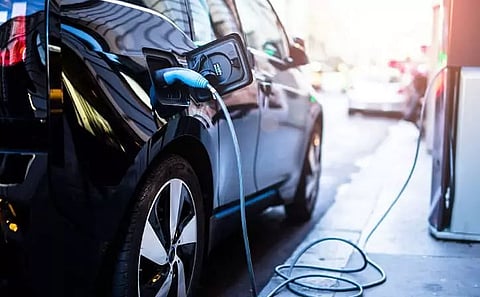
- Home
- Live Blog
- Breaking News
- Top Headlines
- Cities
- NE News
- Sentinel Media
- Sports
- Education
- Jobs

The slow pace of Faster Adoption and Manufacturing of (Hybrid and) Electric Vehicles in India (Fame-India) has posed tougher challenges to India in achieving its electric mobility targets. Apart from contributing to the reduction of air pollution, fast-tracking Fame-India implementation is also important to reduce the country's oil import bill. The county's oil import bill nearly doubled to 119 Billion US dollars in the 2021-22 financial year that ended on March 31 compared to 62 Billion US dollars in 2020-21. Data released by the Petroleum Planning and Analysis Cell of the Ministry of Petroleum and Natural Gas show that the sale of Compressed Natural Gas (CNG) passenger vehicles increased to 12.09% in 2021-22 from 7.79 in 2021 while the sale of passenger cars under EV segment marginally increased from 0.03% (427) in 2020-21 to 0.36 % (5286 cars) in 2021-22 while the market share of conventional petrol and diesel cars decreased to 87.55% from 92.19% in 2020-21 financial year. In the case of utility vehicles, the sale of EVs increased to 1.11% from 0.52% in 2020-21 to 1.11% in 2021 while the sale of CNG vehicles jumped to 4.12% from 1.56% and the sale of conventional vehicles declined to 94.77% from 97.92%. The sale of CNG vans registered a significant increase to 23.47% as against 17.86% in 2020-21. The Ministry of Heavy Industries notified phase II of the Fame-India scheme in 2019 with an outlay of Rs 10,000 crore to be spent over five years. The Parliamentary Standing Committee on Industry in its report pointed out that less than 50% of the allocated fund has been released since then when three years of the five-year scheme have already elapsed. The parliamentary panel has expressed the view that the FAME-India scheme is of "critical importance for the nation, especially in the present scenario of global uncertainties leading to huge fluctuations in the crude oil prices and therefore, needs to be adequately funded." The Committee recommends that the scheme be extended beyond March 31, 2024, so that the targets set can be achieved, along with an announcement for new incentives like tax rebates and cut on duties on EVs which, the committee said, would accelerate electric mobility. Three major hurdles in faster EV adoption in the country which the Automobile Associations listed before the committee are high upfront price, lack of confidence in new technology and concerns relating to charging of vehicles. The Committee notes in its report that introducing the new battery swapping policy and recognizing battery or energy as a service as announced in the Union Budget 2022 will help to develop EV infrastructure and increase the use of EVs in public transportation. It would motivate businesses engaged in delivery and ride aggregation businesses to incorporate EVs into their fleet and would create new avenues for companies to venture into the business of battery swapping, states the report. The Committee hopes that this policy will address the last-mile connectivity issue for both passenger and commercial vehicles, encourage fresh investments for indigenous battery makers and provide impetus to the entire EV Ecosystem including manufacturers and charging infrastructure players. Visibility of the charging stations and battery swapping centres along key highways and cities is critical to infusing confidence among vehicle buyers to go for EVs. Another key problem highlighted by Automobile Associations is the lack of supply chains for parts and components used in manufacturing EVs and EV batteries which need to be factored into FAME-India implementation strategies and setting the target dates. Automobile Industry welcomes the new policy announcement and hoped that it would create a favourable ecosystem for EV promotion in the country. The NITI Aayog has put the draft Battery Swapping Policy in the public domain on April 20 which will be open till June 5 for comments. The policy proses that vehicles with swappable batteries will be sold without a battery, providing the benefit of lower purchase costs to potential EV owners.
The Policy is targeted at supporting the adoption of battery-swapping primarily for battery swapping systems destined to be used for light electric power train vehicles and E-Rickshaw/E-Cart. However, this does not preclude the government from extending its coverage to other EV segments in the future, it says, which has kept the policy flexible. It underlines the importance of reuse of end-of-first-life swappable batteries and recycling of end-of-life batteries and stipulates the minimum technical and operational requirements that battery swapping ecosystems would need to fulfil, to enable effective, efficient, reliable, safe and customer-friendly implementation of battery-swapping infrastructure. One of the advantages of swapping highlighted in the policy is that charging stations require more space since vehicles need to be parked next to the chargers during the charging process but battery swapping stations can stack multiple batteries, and require limited parking, which would address space constraints in urban areas. The policy is expected to boost EV adoption in India.